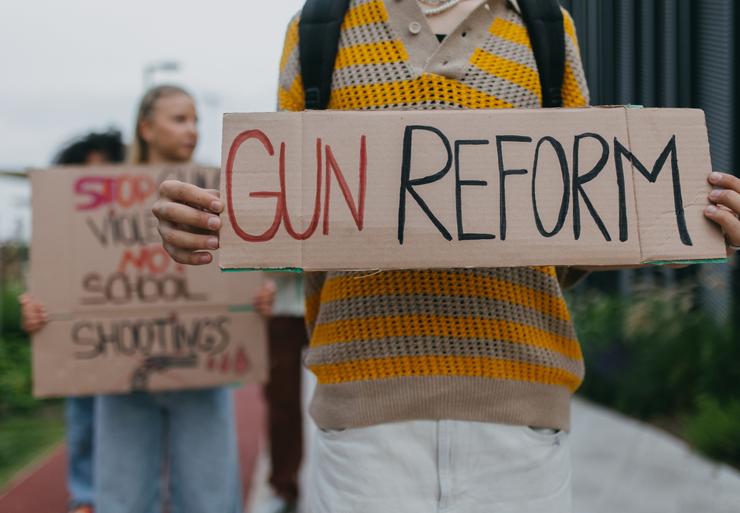Gun safety was a winning issue for Democrats in recent state elections. But will calls for tighter gun laws — along with messaging that, as a Biden administration strategy memo put it, a second Donald Trump term would mean “more guns, more shootings, more deaths” — give Democrats an electoral edge in 2024?
I’m a Tennessee-based gun safety researcher, and I’ve spent much of the past decade studying beliefs about guns across red- and purple-state America. My research has led me to believe that Democrats can cut into what often wrongly appears to be monolithic Republican support for unregulated guns, particularly given current troubles at the National Rifle Association. But doing so requires better ways of engaging conservative gun owners, many of whom see gun reform as elitist or disconnected from their concerns.
Given my research, I have little doubt that Democrats are on the correct side of an issue that candidates from the top of the ticket down rightly call an urgent public health crisis. But I’ve learned time and again how guns pose different kinds of risks, and represent different social and political symbols, than do cigarettes, faulty automobiles or other targets of health campaigns that join government regulations with corporate accountability to spur changes in behavior.
My scholarship and that of other researchers working in red and purple communities suggest five key points that Democrats might keep in mind as the November elections approach:
Democrats protest… but Republicans vote.
Gun safety advocates frequently cite data showing how harm-reduction strategies, such as background checks and assault rifle bans, remain popular with majorities of both gun-owning and non-gun owning Americans.
However, supporting polices is very different from voting for them. Support for gun reform peaks in the four days following mass shootings, but historically that emotion wanes, and gun issues alone fail to yield better Democratic voter turnout. By contrast, conservative gun owners vote for pro-gun candidates consistently and reliably, and they punish Republican politicians who make even modest signals toward gun reform.
That calculus might be changing, thanks to the remarkable efforts of grassroots groups and new waves of reform-minded candidates. But this is a marathon, not a sprint: Years of mobilizing ardent voter blocs allow the GOP to control key legislative bodies, judgeships, donor bases, governing boards and other levers of authority in ways that are often immune to shifts in popular opinion. Institutional change, not just policies, needs to be the aim.
Health mandates won’t shift the U.S. gun debate.
Democratic messaging that frames gun safety as “common sense” can strike gun owners as nonsensical because of their beliefs about autonomy. A man who lives on a farm in Tennessee and owns multiple AR-15s told me how the idea of government regulating his “freedoms” — manifested through background checks requiring that he enter personal identification into government databases or the red flag laws that expand police authority — filled him with anger and dread.
“I’m not going along with gun control because the very act of banning or confiscating guns reinforces the reason I own them in the first place,” he said. “And in any case, the government isn’t going to save you from violence.”
I’ve interviewed Southern gun owners of color whose mistrust of gun reform rests on suspicion of authority as well.
“I’m going to call the cops on my uncle?” a Black woman in Kentucky replied about a relative who recently purchased a rifle when I asked her about red flag laws, which aim to keep guns from those deemed a danger to themselves or others. “I don’t think so.”
For these gun owners, resistance to reform is not just based on misinformation about government tyranny but also on material realities that shape perceptions of security in their lives. Shaping their views about gun safety needs to go beyond messaging about established public health interventions to address how and why they feel unsafe.
Tie gun reform to a larger issue: safety.
Concerns about crime consistently rank among the primary reasons for gun ownership.
Democrats can fall into a trap of addressing such fears with data showing that permissive gun laws are associated with higher rates of violence and that crime rates are in any case falling.
Talk to Southern gun owners for more than five minutes and they’ll gladly deconstruct this scenario for you through NRA-style “bad guy, good guy” logic: “The bad guys have guns so why shouldn’t we?”
Their assumptions are often replete with stereotypes, but they are not wholly wrong: Nothing in the “commonsense” approach defines people who own guns illegally, and whether methods designed to treat guns as health risks also lower crime rates is debatable.
It was not always so. Through the 1990s, gun safety reform focused systematically on crime reduction. But perhaps its most effective intervention ― an assault weapon ban as part of the notorious 1994 crime bill — led to profoundly disparate racial outcomes.
Over subsequent years, a divide grew between “legal” and “illegal” guns and gun markets, the former comprising guns sold by licensed dealers and bought by law abiding owners, while the latter is the stuff of criminals. And the former became the domain of public health — prevention focused on accidental shootings, suicides, mass shootings and other tragedies wrought by “legal” guns, more than on crime — while the “illegal” was the responsibility of police.
How can gun reformers and their Democratic representatives speak more convincingly to this issue? Better messaging is part of the battle. But broaching rule-of-law topics more directly would also require addressing, with greater precision at policy levels, how and why guns move from “legal” to “illegal” gun markets. Or tracking how and why public-health-based gun safety policies lower specific types of crime. Or researching and championing effective models of policing in places with lax gun laws and an increasingly armed populace.
Though many Democrats might not want to go there in an election year, better strategizing the impasse between gun safety reform and crime might make it easier for candidates to critique GOP policies that clearly increase crime, such as the disastrous “guns in trunks” legislation in Tennessee that spurred more gun thefts.
Doing so might do more than just help Democrats in the South. Growing numbers of people in blue cities also cite concerns about crime. Yet the terrain for addressing it is ceded to Republican candidates like Lee Zeldin, who used the NRA playbook to run a surprisingly competitive race for the New York governor’s office in 2022, and former sheriff Dave Reichert, who appears to be doing the same in 2024 as a gubernatorial candidate in historically blue Washington state.
Tie gun reform to an even larger issue: capitalism.
Gun rights are big business, a point illustrated by Andrew C. McKevitt’s excellent book “Gun Country,” which is why reform in places like Tennessee remains difficult.
However, a growing body of research combines public health with methods from economics and urban studies to suggest new forms of gun safety entrepreneurialism.
For instance, jobs programs, better civic infrastructure and neighborhood renewal reduce gun crime at rates that surpass those produced by gun laws alone. These interventions do not mandate individual behaviors but instead provide frameworks for ways that gun safety advocates could partner with builders, employers, developers and city planners to define and construct safe neighborhoods — or align with economists and businesses to show how gun safety can be pro-growth. Doing so could also help create economic benchmarks, showing how investments in “place” enable communities to prosper not through mandates but via reinforcement algorithms created by health insurers to reward healthy behaviors.
Incentivizing public safety could then counter concerns that Democrats and public health experts fail to pay enough attention to the economic implications of their interventions — a chorus that grew ever louder during the pandemic.
Win productively.
In our zero-sum political system, winning elections is a requisite step for change. Winning lets you seat judges, allocate resources and enact laws.
But winning the 2024 election would also afford Democrats the opportunity to reboot the American gun debate and its false binary of health on one side and freedom on the other. Over the course of many interviews, I’ve learned that pretty much everyone wants health and safety, and pretty much everybody values autonomy.
Doing so means recognizing that promoting laws and mandates by themselves will have little effect if not accompanied by efforts to build actual and virtual structures that reward cooperation over competition and that envision public spaces in which people feel free to engage in pursuit of life, liberty and happiness without fear of becoming victims of the next mass casualty event.
The gun debate presents a seemingly intractable wedge issue, but it could present an opportunity to form broader coalitions that join public health know-how with structural support for the safety of public spaces, the economy and democratic institutions.

